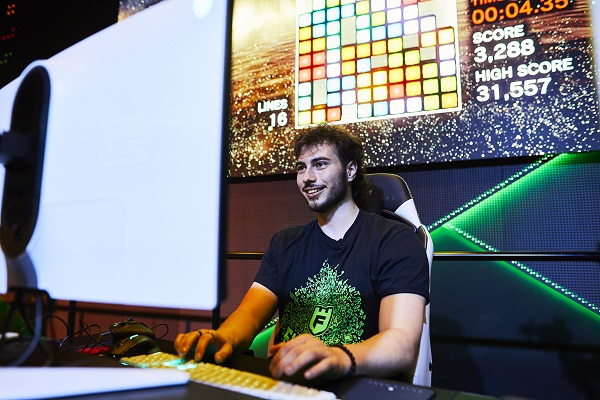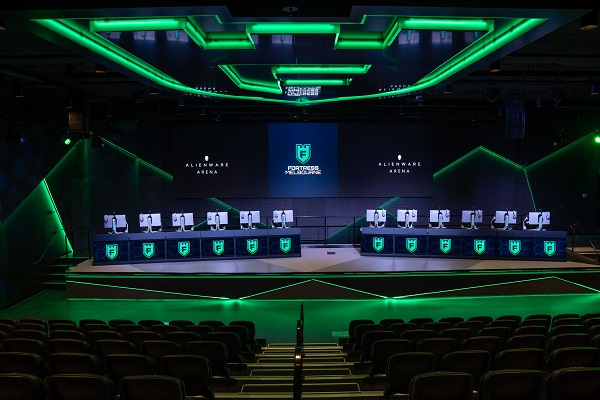Players, enter the arena: eSports arenas and AV

Tech requirements for eSports areas can vary depending on the game but generally include a PC, keyboard, mouse, KVM and noise-cancelling headphones.
eSports is a fast-growing area of technology and, already, there are companies who have got in on the action, building eSports arenas to facilitate the ever-growing trend. Nick Ross found out more.
In 2017, the Intel Extreme Masters eSports international gaming tournament landed in Sydney and 7,500 young people gathered to watch two teams of five, quietly play an aging remake of a 20-year-old video game, behind monitors, with their headphones on. The atmosphere and noise weren’t far from what you’d expect at a FIFA World Cup Final… and for a Sydney sports crowd, that’s really saying something.
The Sydney event wasn’t even close to being the largest in the world, or even Australia. Many tournaments are bolted on to massive, video game expos like PAX and ESL’s Dreamhack, which are now regular visitors to Melbourne. Newcomer, The Game Expo has since joined them.
ADVERTISEMENT
At each event you can expect there to be some form of traditional tradeshow stands but, in the gaming world, these can be incredibly expensive and elaborate. It’s not hard to see why. Outdoing rivals, impressing young gamers and generally standing out seriously matters to an industry which, in Australia in 2022, PWC found was worth $4.17bn. That’s more than both Australia’s film industry and music industry… combined.
What’s more, every major traditional sport has lamented a decline in new, young supporters in recent years, saying that they’d rather be playing games like Fortnite than supporting their local footy team. While this has led to improved, live, on-screen graphics, telemetries, and fantasy league score-update overlays to improve viewer immersion and reverse the decline, the rise of eSports continues unabated.
Naturally, this presents opportunities for the professional AV industry, especially in the competitive eSports space. However, eSports staging requires unique considerations. So, what’s going on and what do you need to know?
What games are played?
Despite, the ever-expanding variety of games on the market, competitive eSports tends to stick to stalwarts that define a few, core genres. Top of the list are First Person Shooters. These are usually played on PCs but console-based tournaments happen too. Games include Counter Strike (CS:GO), Apex Legends, Overwatch, Call of Duty, Rainbow 6 and Valorant.
Another popular PC-focused genre is MOBA (Multiplayer Online Battle Arena). These evolved out of slower, more-complex Real-Time Strategy (RTS) games like Starcraft (which used to be obscenely popular) and include Dota 2 and League of Legends. They eschew slow-paced strategy and complexity for action, teamwork and excitement which also makes for a better audience spectacle.
Fighting games (including Super Smash Bros, Street Fighter and Tekken) and sports games (like FIFA and NBA 2K) are also popular while eRacing tournaments are growing in popularity too – helped by the fact that several young Formula 1 drivers now compete and stream in their downtime.
What does an eSports arena look like?
eSports arenas come in all sizes but, fundamentally, the core platform remains the same while the staging scales according to the available space. Events may feature local meetups, qualifiers for larger tournaments or international finals and they may tour in venues ranging from rock-music-sized arenas (even stadia) to installations on trade-show floors. Smaller, pub-sized, specialist venues, with permanent stages, are also thriving.
Fortress in Melbourne is one of the latter. It’s a gaming venue that features multiple, game-themed bars and is home to The Alienware Arena – the largest fixed, eSports arena in the Southern Hemisphere. Its production manager, Chris Stewart, says that the AV requirements for staging competitive gaming are generally similar for all venue sizes:
“But, as Fortress is a smaller venue, we prefer more compact solutions.”
Providing for the players
Requirements can vary per game, but MOBA games and Shooters typically involve two teams of five players. Impermanent installations will require dealing with publishers, players (and team management), tournament and league operators plus brands and sponsors who will provide advice, technical and branding requirements and often, all the players’ gaming equipment for the stage. At large, major events, competitors may require their own practice rooms (with PCs) for each team to warm up in.
Each player needs a high-spec PC, gaming monitor, gaming headset, keyboard, mouse and (depending on sponsorship) a gaming chair. Competitive players and professionals will usually bring their own mouse, keyboard and headset. It might sound like a trivial consideration but plugging and unplugging peripherals into a PC can cause all manner of problems, especially if ports are at the rear and the computer has been built into the stage for neatness. Fortress addresses this by putting USB ports in the monitor feet for seamless switching.
Elsewhere, racing games will require high-quality ‘sim rigs’ (with specialist seats, plus high-quality steering wheels and pedals). Fighting games simply require a game console and a zero-input-lag (TV) screen that players will share. They’ll often bring their own controllers.
Teams need teammates sat closely together but away from opposing teams. Some competitions provide sound-proof boxes to avoid fans yelling out tactical information. However, the difficulties in providing such a set-up means it’s not always considered essential.
Still, it’s something that Fortress takes very seriously. Chris says: “It is very important that we prevent competitors from hearing the audience or the casters [commentators]. The primary way we solve this is by using noise-cancelling headsets. These types of headsets use a combination of passive noise reduction and microphones that have very particular polar patterns and frequency ranges which reduce ambient noise from bleeding into what the players hear. In terms of seeing the displays, it depends on the venue/space. Some common solutions are showing gameplay only on displays that are out of view of players or having staff watching over them, at all times, to prevent turning around.”
Another core requirement for participants is network lag. At the top level, competitors have refused to play if they have a miniscule, 4ms ping when an opponent has 2ms. Chris explains that this can be reduced in a variety of ways depending on the game with the most common being to play on a locally hosted server.
He adds: “This ensures near-zero latency for players and guarantees an equal playing field. Where this is not possible, we ensure all PCs are equally routed to the same remote server.”
Even though the core networking is local, you still need a fast and robust internet connection. Games often require huge updates that can be tens of gigabytes in size. Players also need to download their small-but-essential, personalised, game-configuration files to avoid lengthy text-entry sessions.
Informing the audience
Meanwhile, the audience needs to know what’s going on with each team. Shooter and MOBA games will benefit from two feeds (one for each team) but, in a pinch, can use one stream. The larger the venue, the larger the screens. At least one specialist commentator will be required, along with a production engineer who can identify where the action is happening and display the relevant feed on the audience’s screen(s). Invariably, a KVM is required.
Chris says that in a broadcast or AV setting, using KVM switches is crucial for ensuring optimal performance – these switches must possess low latency and the capability to connect to displays through interfaces like HDMI and USB 3.0.
Chris remarks: “This allows for the seamless integration of a keyboard, mouse and monitor and other peripherals such as control surfaces. It is important to note that the use of KVM switches for players is not recommended due to the potential for introducing latency, which can negatively impact overall performance. The key is ensuring our systems have no impact on the PCs.”
It’s been common to see both projectors and LED screens used at different-sized venues. Fortress prefers LED displays as they are brighter and less affected by external lighting, haze or fog.
So how many different audience screens does Fortress use?
Chris explains: “In addition to our primary LED wall display, we also incorporate supplementary stage displays to enhance the viewing experience for the audience. These additional displays, one for each player, mean we can showcase players’ camera shots, gameplay and even unique graphics. This approach allows us to provide a more immersive and dynamic experience for the audience, as they are able to see, not only the overall action on the stage, but also the perspectives of individual players and replayed highlights.”
Great care is taken to ensure that the pixel pitch of the main display is optimally suited for viewing from the closest, seated distance to guarantee an equal experience for all members of the audience. Additionally, the resolution must be carefully selected to align with the design of the display and to ensure that the audience can clearly discern all visual elements.
As for expert commentators, Chris advises that people with expertise in the game or community are used, in the same way that they are in traditional sports: “In certain instances, having influencers or celebrities on stage can add an element of excitement (or provide casual entertainment) to the event in general.”
Lag is an audience-related consideration, too. In this regard, it’s similar to a rock concert where it’s hard to sing along and be immersed when the music is out of sync with the singer.
Chris adds: “It’s also crucial for the technical and logistical aspects of the production. For example, audio synchronisation with video is much easier if there is less inherent lag. Usually, the ability to reduce lag in video comes down to a few key factors: the type of signal used, the quality of equipment used, and the amount of conversion and number of devices that the signal travels through. For us, this means we maintain SDI [Serial Digital Interface] with as little conversion as possible and directly feed it into our Ross Video gear, reducing as many hops as we can before it hits the LED Wall.”
Beyond that, sound and lighting systems will be required as per any sporting, music or awards event. A scoreboard will help people track progress across matches that can go beyond 50 rounds.
Supply of power, Chris says, is another big factor: “For players, the primary requirement is to ensure that you have enough wattage (and spare leftover) to power the PC itself as well as the monitor and any additional accessories. You would be hard-pressed to have an issue here, as most setups are no more complicated than your average gamers’ PC setup at home.
“For the AV tech and equipment used, there is a lot of due diligence and design involved in the early stages of building these types of venues to ensure your load does not exceed capacity. As much as possible, equipment is rack-mounted and, in some cases, provided with a UPS battery in the event of a power failure.”
And the eSports parade keeps marching – Fortress Sydney plans to open at Central Park Mall in the first half of 2023. There’s no pressing pause on this movement.
-
ADVERTISEMENT
-
ADVERTISEMENT
-
ADVERTISEMENT
-
ADVERTISEMENT


